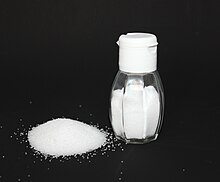Chemical species are a specific form of chemical substance or chemically identical molecular entities that have the same molecular energy level at a specified timescale. These entities are classified through bonding types and relative abundance of isotopes. [1] Types of chemical species can be classified based on the type of molecular entity and can be either an atomic, molecular, ionic or radical species.
Classification[edit]
Generally, a chemical species is defined as a chemical identity that has the same set of molecular energy levels in a defined timescale (i.e. an experiment). These energy levels determine the way the chemical species will interact with others through properties such as bonding or isotopic compositions. The chemical species can be an atom, molecule, ion, or radical, with a specific chemical name and chemical formula. [2]
In supramolecular chemistry, chemical species are structures created by forming or breaking bonds between molecules, such as hydrogen bonding, dipole-dipole bonds, etc.[3] These types of bonds can determine the physical property of chemical species in a liquid or solid state.[4]
The term is also applied to a set of chemically identical atomic or molecular structures in a solid compound.

Types of Chemical Species[edit]
Atomic species: Specific form of an element defined by the atom's isotope, electronic or oxidation state. Argon is an atomic species of formula Ar.[5]
Molecular species: Groups of molecules that are held together by chemical bonds. An example is Dioxygen and ozone with respective chemical formulas O2 and O3[6]
Ionic species: Atoms or molecules that have gained or lost electrons, resulting in a net electrical charge that can be either positively (cation) or negatively charged (anion).
- Species with an overall positive charge will be an cationic species. Sodium ion is an example of cationic species and its formula is Na+
- Species with an overall negative charge will be an anionic species. Chloride is an anionic species and its formula is Cl−[7]
Radical species: Molecules or atoms with unpaired electrons. Triarlborane anion is a radical species and its formula is Ar3B−[8][9]
Chemicals can be two different types of species, for example, nitrate can be a molecular and ionic species; its formula being NO3−. Note that DNA is not a species, the name is generically applied to many molecules of different formulas (each DNA molecule is unique)[10]
See also[edit]
References[edit]
- ^ Qu, Ke; Dan, Dezhong (2024-01-01), Qu, Ke; Dan, Dezhong (eds.), "Chapter 3 - Chemical speciation analysis", Environmental Analytical Chemistry, Elsevier, pp. 65–100, ISBN 978-0-443-21966-5, retrieved 2024-04-15
- ^ Chemistry (IUPAC), The International Union of Pure and Applied. "IUPAC - chemical species (CT01038)". goldbook.iupac.org. doi:10.1351/goldbook.CT01038. Retrieved 2024-04-01.
- ^ Steed, Jonathan W.; Atwood, Jerry L. (2022-02-22). Supramolecular Chemistry. John Wiley & Sons. ISBN 978-1-119-58251-9.
- ^ "Chapter 5: Collections of Chemical Species". UCalgary Chemistry Textbook. Retrieved 2024-04-01.
- ^ Chemistry (IUPAC), The International Union of Pure and Applied. "IUPAC - chemical species (CT06859)". goldbook.iupac.org. doi:10.1351/goldbook.CT06859. Retrieved 2024-04-12.
- ^ Atkins, Peter; Paula, Julio de; Friedman, Ronald (2023), Physical Chemistry: Quanta, Matter, and Change, Oxford University Press, doi:10.1093/hesc/9780199609819.001.0001/isbn-9780199609819 (inactive 2024-04-15), ISBN 978-0-19-199214-8, retrieved 2024-04-15
{{citation}}: CS1 maint: DOI inactive as of April 2024 (link) - ^ Szwarc, Michael; Van Beylen, Marcel (1993), "Ionic Species", Ionic Polymerization and Living Polymers, Dordrecht: Springer Netherlands, pp. 39–85, doi:10.1007/978-94-011-1478-3_2, ISBN 978-94-010-4649-7, retrieved 2024-04-12
- ^ Su, Yuanting; Kinjo, Rei (2017-12-01). "Boron-containing radical species". Coordination Chemistry Reviews. 352: 346–378. doi:10.1016/j.ccr.2017.09.019. ISSN 0010-8545.
- ^ Hicks, Robin G., ed. (2010-07-13). Stable Radicals. Wiley. doi:10.1002/9780470666975. ISBN 978-0-470-77083-2.
- ^ Caruthers, Marvin H. (January 2013). "The Chemical Synthesis of DNA/RNA: Our Gift to Science". Journal of Biological Chemistry. 288 (2): 1420–1427. doi:10.1074/jbc.x112.442855. ISSN 0021-9258. PMC 3543024. PMID 23223445.